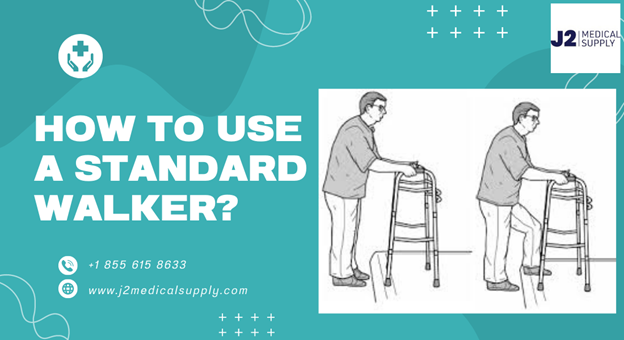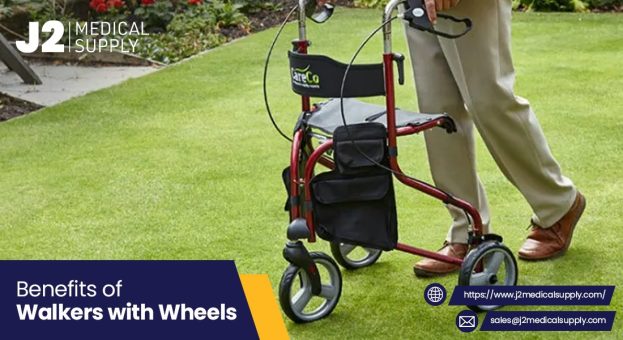Are you seeking enhanced stability and improved mobility during outdoor walks and wondering how to use a standard walker? Look no further! In this comprehensive guide by J2 Medical Supply, we will explore the correct usage of a standard walker, a reliable mobility solution designed to support and assist individuals with limited mobility. Whether recovering from an injury, managing a chronic condition, or requiring extra stability while walking, understanding the proper techniques for using a standard walker can significantly enhance your overall safety and confidence.
This article will delve into step-by-step instructions and expert tips from physical therapists specializing in mobility aids. By following their guidance, you can maximize the stability and support a standard walker offers, ensuring safe and efficient movement during your daily activities.
How to Use a Standard Walker: Mastering Stability and Enhancing Mobility
Utilizing a standard walker correctly can profoundly impact your mobility and overall well-being. Physical therapists often recommend standard walkers as effective mobility aids due to their versatility and ability to accommodate different user needs. Whether you require additional stability on uneven surfaces or assistance with balance, a standard walker can offer the necessary support to help you move confidently.
With its sturdy frame and ergonomic design, a standard walker can help distribute your weight evenly, reducing strain on your joints and minimizing the risk of falls or injuries. Using a standard walker during outdoor walks allows you to enjoy greater independence and engage in daily activities with enhanced stability.
How to Choose a Standard Walker?
Selecting the right standard walker ensures optimal stability and support while navigating outdoor environments. With a wide range of options available, it’s essential to consider certain factors to make an informed decision. Here are some tips to consider when getting a standard walker:
● Consult with a Physical Therapist
Start by consulting with a physical therapist who specializes in mobility aids. They can assess your requirements and recommend the most suitable type of walker for your unique situation. Whether it’s a front-wheeled walker, rollator, or 3-wheeled walker, their expertise will guide you in making the right choice.
● Consider Mobility Needs
Evaluate your mobility needs to determine your required features in a standard walker. Assess factors such as weight capacity, height adjustability, and manoeuvrability. For individuals with limited strength, lightweight and foldable options may be more suitable, while those with balance issues may benefit from walkers with wider bases for increased stability.
● Test for Comfort and Fit
When selecting a standard walker, prioritize comfort and proper fit. Ensure the handles are comfortable, allowing for a slight bend in your elbows when gripping them. The walker should also provide ample clearance for your stride to prevent tripping. Test different models to find the most comfortable and supportive for your body.
● Evaluate Durability and Quality
Look for a standard walker constructed from durable materials to ensure long-lasting use. Check for sturdy frames, secure locking mechanisms, and durable wheels that withstand regular outdoor walking activities. Quality craftsmanship is essential to ensure your walker remains reliable and safe over time.
● Consider Portability and Storage
If you frequently use your standard walker outside the home, consider its portability and storage options. Look for models that are lightweight, foldable, and easy to transport in vehicles or on public transportation. Additionally, assess whether the walker can be conveniently stored in your living space without causing clutter.
Steps to Use a Standard Walker?
In this step-by-step guide, we will walk you through using a standard walker to maximize its benefits as a reliable mobility solution.
1- Adjust the Height
Start by adjusting the walker’s height to suit your comfort and posture. Stand upright with your shoes on and let your arms hang naturally by your sides. The handles of the walker should align with the crease of your wrist, allowing for a slight bend in your elbows.
2- Stand between the Handles
Position yourself between the walker’s handles, ensuring a firm grip on both sides. Keep your body centred and balanced, with your weight distributed evenly.
3- Move the Walker Forward
Step forward with the walker, moving it a short distance ahead of you. Ensure all four legs of the walker are firmly on the ground before proceeding.
4- Step into the Walker
Step forward with the unaffected or more muscular leg, placing it within the boundaries of the walker’s frame. Follow with the weaker or affected leg, ensuring it stays within the walker’s structure.
5- Repeat the Process
Continue moving the walker forward and stepping into it with alternate legs, maintaining a steady pace. Take small, controlled steps, focusing on keeping your balance and stability.
6- Situational Awareness
Be aware of your surroundings while using the walker. Watch out for obstacles, uneven surfaces, or potential hazards that may require adjusting your path or approach.
In conclusion, using a standard walker correctly can significantly enhance stability and promote independence for individuals with mobility challenges. By following the guidelines mentioned in this guide, you can ensure a typical walker’s safe and effective use. J2 Medical Supply, an MBE-certified manufacturer and supplier, is dedicated to providing high-quality medical solutions that help lower costs, improve quality, and achieve supplier diversity objectives. With their commitment to customer satisfaction and superior products, J2 Medical Supply is a reliable partner in meeting your healthcare needs. Choose J2 Medical Supply for a trusted standard walker that will enhance stability, improve mobility, and empower you to regain confidence in your daily activities.




